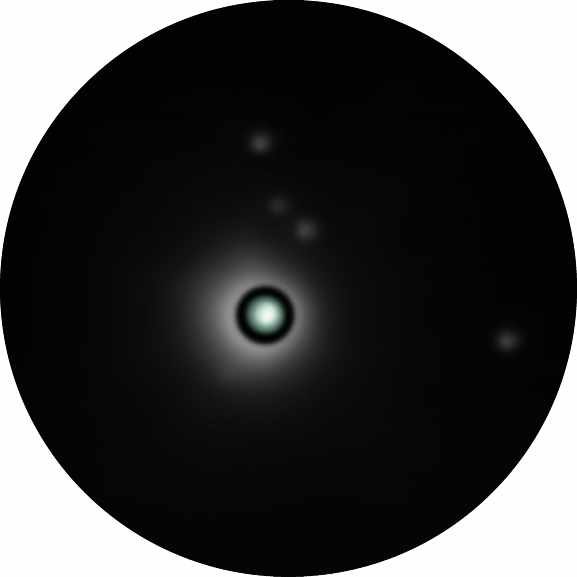Our celestial neighbourhood in February
PICK OF THE MONTH: Uranus
Best time to see: 1 February, 19:00 UT Altitude: 50˚
Location: Aries
Direction: South-southwest
Features: Colour, moons, faint banding visible with larger instruments
Recommended equipment: 150mm or larger

The observational window for Uranus worsens this month, so you might be forgiven for questioning why we’ve chosen it as the month’s best planet. Despite its slowly deteriorating position, it currently has the highest declination of all the main planets, and this means it still maintains a decent altitude after the evening sky darkens. On 1 February, the mag. +5.8 planet appears just west of south as true darkness falls. At this time its altitude is around 50˚, way better than any other planet on view from the UK.
Things do progressively get worse through the month. By the middle of February, Uranus has an altitude of 44˚ as darkness falls, a figure which drops to 34˚ by the month’s close. Despite the decline, Uranus remains a viable target all month.

A telescope is required to show Uranus as anything more than a star-like dot, and to reveal its green hue. A magnification of 200x or greater will reveal the ice giant’s small, but unmistakable disc.
Currently, Uranus appears 3.5 arcseconds across. For comparison, Ganymede, the largest of Jupiter’s moons and the largest moon in the Solar System, has an apparent diameter of 1.8 arcseconds when Jupiter is near opposition, about half the apparent size of Uranus. Neptune, the Solar System’s outer planet, presents a disc 2.2 arcseconds in diameter.
Uranus sits 24 arcminutes southsoutheast of 29 Arietis at February’s start, the star and planet forming a well-matched visual pair. On 7 February, a 43%-lit waxing crescent Moon sits 1.5˚ to the south of Uranus (centre-to-centre).
Mercury
Best time to see: 1 February, 20 minutes before sunrise Altitude: 4˚ (very low)
Location: Sagittarius
Direction: Southeast
Mercury is a morning object, starting the month fairly faint at mag. +1.2 and poorly placed, rising above the southeast horizon 60 minutes before the Sun. That offset is maintained through to greatest western elongation, which is reached on the 16th, when Mercury will have brightened to mag. +0.1. On its return approach to the Sun, Mercury brightens, while its morning sky position gradually deteriorates.
Venus
Best time to see: 28 February, 40 minutes before sunrise Altitude: 10˚
Location: Sagittarius
Direction: Southeast
Venus is a morning planet, rising two-and-a-quarter hours before the Sun at the month’s start, and two hours before the Sun on the 28th. It will appear low above the southeast horizon, shining at mag. –4.5. Mars lies less than 7˚ south of Venus mid-month, being dimmer at mag. +1.3. On the 27th, Mars lies a little over 5˚ below Venus under a brighter dawn sky. A 15%-lit waning crescent Moon also sits less than 5˚ south of Mars. Through a telescope, Venus appears as a 15%-lit crescent with an apparent disc diameter of 49 arcseconds on the 1st. By the month’s end, the phase is 37%-lit and the diameter is 31 arcseconds.
Mars
Best time to see: 28 February, one hour before sunrise Altitude: 3˚ (very low)
Location: Sagittarius
Direction: Southeast
Mars rises 110 minutes before the Sun at the start of February, shining at mag. +1.4 in Sagittarius, the Archer. In this part of the sky, Mars never rises to a high altitude before sunrise and this makes it harder to see. The difference in time between sunrise and Mars rising decreases over the month so that by the 28th, it rises 90 minutes before the Sun. Its brightness increases to mag. +1.3, and it will be easier to spot as it sits 5.1˚ south of mag. –4.5 Venus.
Jupiter
Best time to see: 1 February, 30 minutes after sunset Altitude: 14˚ (low)
Location: Aquarius
Direction: Southwest
Shining at mag. –1.9 against the stars of Aquarius, Jupiter is engulfed in the evening twilight. A slender 3%-lit waxing crescent Moon sits below the planet, low above the post sunset westsouthwest horizon on the 2nd. The gas giant is lost from view for the month’s latter half after its apparent separation from the Sun becomes too small.
Saturn
Saturn lines up with the Sun on the 4th and is poorly placed when it re-emerges into the morning sky. It’s therefore unlikely to be seen this month.
Neptune
Best time to see: 1 February, 18:50 UT Altitude: 14˚
Location: Aquarius
Direction: West-southwest
The evening twilight catches up with Neptune this month, the planet unable to maintain a useful altitude in darkness following sunset.
More ONLINE
Print out observing forms for recording planetary events
The planets in February
The phase and relative sizes of the planets this month. Each planet is shown with south at the top, to show its orientation through a telescope

Jupiter’s Moons: February
Using a small scope you can spot Jupiter’s biggest moons. Their positions change dramatically during the month, as shown on the diagram. The line by each date represents 00:00 UT.
